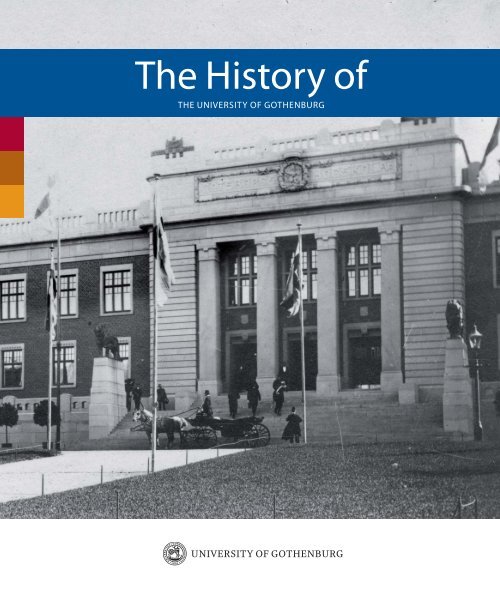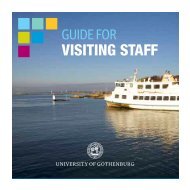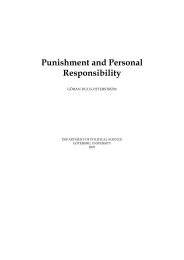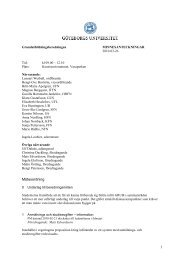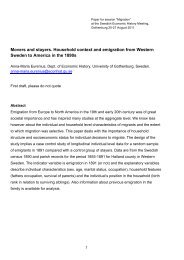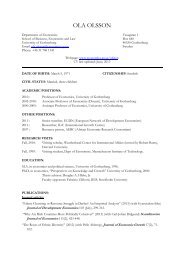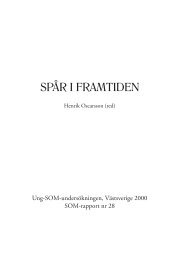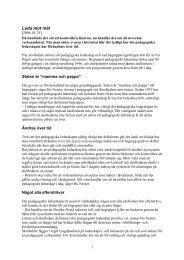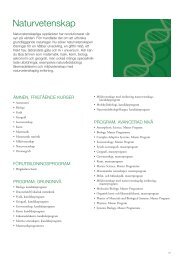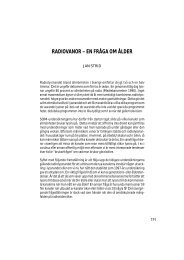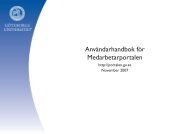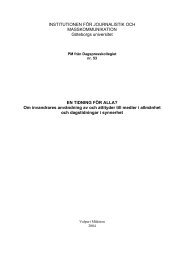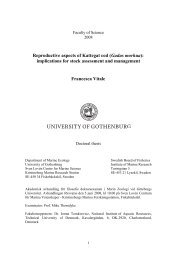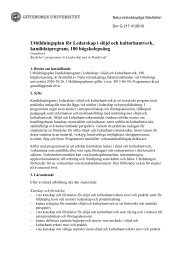The History of - Göteborgs universitet
The History of - Göteborgs universitet
The History of - Göteborgs universitet
You also want an ePaper? Increase the reach of your titles
YUMPU automatically turns print PDFs into web optimized ePapers that Google loves.
<strong>The</strong> <strong>History</strong> <strong>of</strong><br />
THE UNIVERSITY OF GOTHENBURG
Reg.nr: 3750M<br />
FRONT COVER<br />
<strong>The</strong> University building in the early 1900s.<br />
BACK COVER<br />
In the early 1930s, there were 300 students enrolled at Gothenburg<br />
University College (<strong>Göteborgs</strong> högskola). Two hundred<br />
<strong>of</strong> them were members <strong>of</strong> the student union, here gathered in<br />
front <strong>of</strong> the University Main Building in Vasaparken. <strong>The</strong> union’s<br />
inspector Hilding Kjellman, honorary member Johan Vising and<br />
the leader <strong>of</strong> the academic choir Hjalmar Lindroth are shown in<br />
the front row.<br />
BELOW<br />
<strong>The</strong> Assembly Hall in the University Main Building, early 1900s.<br />
Reg.nr: S-000256<br />
Production: Information Office 2012<br />
Print: Billes<br />
Photo: Göran Ol<strong>of</strong>sson and Johan Wingborg<br />
Historic photos: photographers unknown.<br />
Editor: Carina Elmäng<br />
<strong>The</strong> information in this text is from the University’s<br />
booklet Trädet och kronan<br />
(2004) and the book <strong>Göteborgs</strong> <strong>universitet</strong>s historia<br />
I & II by Bo Lindberg and Ingemar Nilsson, among<br />
several other sources.
All we have to <strong>of</strong>fer is a window<br />
that is always open to the rest <strong>of</strong> the world.<br />
This window lets in a draft that<br />
seems to benefit the bacteria <strong>of</strong><br />
freedom and rebellion.<br />
Hjalmar Frisk (1900–84), Vice Chancellor <strong>of</strong> Gothenburg University 1951–1966,<br />
In a speech in connection with the student parliament in Gothenburg 1958<br />
<strong>The</strong> whole context: ‘Students at Uppsala and Lund will find that their Gothenburg<br />
counterparts disappear in the streetscape. Our friends from Stockholm will, in vain, seek<br />
for princesses by blood. All we have to <strong>of</strong>fer is a window that is always open to the rest<br />
<strong>of</strong> the world. This window lets in a draft that seems to benefit the bacteria <strong>of</strong> freedom<br />
and rebellion.’
Crown Prince Gustav, later Gustav V, inaugurating the new building <strong>of</strong> Gothenburg University College in Vasaparken 18 September 1907.
Table <strong>of</strong> Contents<br />
<strong>The</strong> <strong>History</strong> <strong>of</strong> the University <strong>of</strong> Gothenburg ...................................................... 6<br />
A University Emerges ................................................................................................................................ 8<br />
Faculties Evolve .................................................................................................................................................11<br />
‘<strong>The</strong> Pedagogue’ ............................................................................................................................................13<br />
From Medicine to Public Health............................................................................................16<br />
Artistic Education ........................................................................................................................................19<br />
Social Sciences .................................................................................................................................................22<br />
School <strong>of</strong> Business, Economics and Law ..................................................................24<br />
Natural Sciences ............................................................................................................................................26<br />
<strong>The</strong> University Library ...........................................................................................................................28<br />
<strong>The</strong> Inauguration in 1954 ..................................................................................................................29<br />
<strong>The</strong> Open University in the Middle <strong>of</strong> the City ...............................................30
1848 Gothenburg Craft Association started a school on Östra Hamngatan,<br />
which later developed into the School <strong>of</strong> Design and Crafts (HDK).<br />
1861 an idea to establish a science library in Gothenburg was acted upon.<br />
<strong>The</strong> <strong>History</strong> <strong>of</strong><br />
the University <strong>of</strong> Gothenburg<br />
<strong>The</strong> University <strong>of</strong> Gothenburg is one <strong>of</strong> the most<br />
popular universities in Sweden, with the highest<br />
number <strong>of</strong> applicants per place for many programmes.<br />
Besides the attractive downtown location, students<br />
find the great breadth combined with the highly<br />
successful focus on in-depth and cutting-edge research<br />
and education appealing.<br />
6 <strong>The</strong> <strong>History</strong> <strong>of</strong> the University <strong>of</strong> Gothenburg
1864 the idea <strong>of</strong> a free academy in Gothenburg was presented for the first<br />
time, in an article in the newspaper <strong>Göteborgs</strong> Handels- och Sjöfartstidning.<br />
1865 a drawing school with a capacity <strong>of</strong> 170 students per year<br />
was established.<br />
<strong>The</strong> first building <strong>of</strong> Gothenburg University College. Built in 1867 and located at the corner <strong>of</strong> Södra vägen and Parkgatan, it housed the school until 1907.<br />
<strong>The</strong> building was demolished in the 1960s, yet it was considered to be too worn down for lectures to be held there already in the early 1900s.<br />
<strong>The</strong> <strong>History</strong> <strong>of</strong> the University <strong>of</strong> Gothenburg<br />
7
1890 the first course in Gothenburg for teachers <strong>of</strong> textile handicraft was held.<br />
1891 the first pr<strong>of</strong>essors met their students at the beginning <strong>of</strong> the autumn<br />
semester. <strong>The</strong> Gothenburg city library (the predecessor <strong>of</strong> the university library) is<br />
established, based on the museum library.<br />
A University Emerges<br />
<strong>The</strong> University <strong>of</strong> Gothenburg’s cultural heritage<br />
includes thoughts about a free academy in Gothenburg,<br />
first presented in May 1864 in an article published<br />
in the newspaper <strong>Göteborgs</strong> Handels- och<br />
Sjöfartstidning.<br />
‘In brief, it can be described as follows: A free<br />
academy is an institution for free studies <strong>of</strong> modern<br />
subjects conducted for the purpose <strong>of</strong> education<br />
and led by cultural figures who shall also perform<br />
research. <strong>The</strong> studies shall be free in the sense that<br />
they shall not be linked to any academic degrees.<br />
Academic degrees are detrimental to higher studies.<br />
<strong>The</strong>y force students to study the subjects that a certain<br />
degree mandates, and not those that he is interested<br />
in (…) <strong>The</strong> hunger for knowledge is a strong enough<br />
driving force for studies.’<br />
<strong>The</strong> idea was presented by Sven Adolf Hedlund,<br />
at the time a well-known cultural figure and one <strong>of</strong><br />
the 19th century liberals who ended up playing a very<br />
important role for Gothenburg’s cultural and political<br />
development. He was a publisher, editor-in-chief<br />
for <strong>Göteborgs</strong> Handels- och Sjöfartstidning, member<br />
<strong>of</strong> parliament, member <strong>of</strong> the Gothenburg city<br />
council, and the strongest supporter <strong>of</strong> the esta blishment<br />
<strong>of</strong> Gothenburg University College. It was in<br />
the late 1800s that Hedlund, together with the author<br />
and journalist Viktor Rydberg, initiated the debate<br />
about a university college in Gothenburg, the university<br />
college that eventually became the University <strong>of</strong><br />
Gothenburg.<br />
Gothenburg University College opened in a<br />
large wooden building at the corner <strong>of</strong> Södra vägen<br />
and Parkgatan in central Gothenburg. However, the<br />
build ing soon became too small and was in poor condition.<br />
A Gothenburg journalist wrote the following<br />
about a public art lecture: ‘<strong>The</strong> lecture hall was filled<br />
to capacity. It did not seem certain that the floor joists<br />
would be able to carry the load.’<br />
<strong>The</strong> industrialist Oscar Ekman learned about the<br />
situation and felt that something had to be done. He<br />
wanted the university college to be placed in a ‘for<br />
her high purposes worthy building’. In 1902 an architectural<br />
contest was announced. <strong>The</strong> two architects<br />
Ernst Torulf and Erik Hahr won the assignment, and<br />
in September 1907 the last touches were added to the<br />
University building in Vasaparken. <strong>The</strong> full construction<br />
cost <strong>of</strong> 630 000 SEK was paid for by Ekman alone.<br />
<strong>The</strong> Crown Prince at the time, Gustav (later King<br />
Gustav V), inaugurated the new building.<br />
Important dates<br />
Gothenburg University College (1891–1954) consisted<br />
<strong>of</strong> a traditional faculty <strong>of</strong> arts (humanities, social<br />
sciences and partly natural sciences), where the hu-<br />
8 <strong>The</strong> <strong>History</strong> <strong>of</strong> the University <strong>of</strong> Gothenburg
1893 the first course in Gothenburg for teachers <strong>of</strong> home economics was held.<br />
1901 the first pr<strong>of</strong>essorship in political science at Gothenburg University<br />
College is established.<br />
Construction workers working on the foundation <strong>of</strong> the new building, around 1904.<br />
<strong>The</strong> <strong>History</strong> <strong>of</strong> the University <strong>of</strong> Gothenburg<br />
9
1902 an architectural contest for the construction <strong>of</strong> the current University<br />
Main Building in Vasaparken was announced.<br />
1904 the building on Kristinelundsgatan was erected. This building has been<br />
home to what is today the School <strong>of</strong> Design and Crafts since the beginning.<br />
Just having been awarded their doctoral degrees, a group <strong>of</strong> men pose in front<br />
<strong>of</strong> the main building in Vasaparken in 1931.<br />
manities dominated strongly. In 1891 there were seven<br />
pr<strong>of</strong>essors teaching 22 students.<br />
<strong>The</strong> building in Vasaparken was completed in 1907.<br />
<strong>The</strong> Medical College was established in 1949.<br />
Gothenburg University College and the Medical<br />
College merged in 1954, forming the University<br />
<strong>of</strong> Gothenburg. Before the merger, Gothenburg<br />
University College was a foundation financed by private,<br />
municipal and state funds, whereas the Medical<br />
College was state operated. <strong>The</strong> University was inaugurated<br />
on Saturday 2 October 1954.<br />
Several parts <strong>of</strong> today’s University started as<br />
separate schools and colleges. In 1967 the Faculty <strong>of</strong><br />
Odontology was established.<br />
In 1971 the School <strong>of</strong> Business, Economics and<br />
Law became part <strong>of</strong> the University.<br />
In connection with the 1977 higher education<br />
reform, several previously independent teaching<br />
institutions were incorporated into the University,<br />
for example the colleges <strong>of</strong> public administration,<br />
teacher training, journalism, music and performing<br />
arts. As a result, the University <strong>of</strong> Gothenburg became<br />
one <strong>of</strong> the both largest and broadest higher education<br />
institutions in Sweden.<br />
In 1998 the University College <strong>of</strong> Health Sciences<br />
became part <strong>of</strong> the University.<br />
<strong>The</strong> central vocational college had started in<br />
Gothenburg in 1961 with programmes preparing for<br />
example laboratory assistants. Regular health care<br />
assistant programmes emerged in the early 1960s and<br />
programmes for several other health and care pr<strong>of</strong>essions<br />
were started a few years later. Until then health<br />
care workers had received their training directly at<br />
the hospitals.<br />
Health and caring sciences have belonged to the<br />
Sahlgrenska Academy since 2001. <strong>The</strong> IT University<br />
was started in the same year when Chalmers University<br />
<strong>of</strong> Technology and the University <strong>of</strong> Gothenburg<br />
joined forces to introduce new and advanced programmes<br />
within IT.<br />
<strong>The</strong> oldest part <strong>of</strong> the University <strong>of</strong> Gothenburg<br />
is what used to be named Lärarhögskolan, which<br />
was the college <strong>of</strong> education. <strong>The</strong> Board <strong>of</strong> Teacher<br />
Education (LUN) was established in 2001 to link<br />
education and research in the different teacher training<br />
programmes.<br />
In 1977 Lärarhögskolan became part <strong>of</strong> the University.<br />
10 <strong>The</strong> <strong>History</strong> <strong>of</strong> the University <strong>of</strong> Gothenburg
1905 the union between Norway and Sweden was dissolved.<br />
1907 the university building in Vasaparken opened its doors in September<br />
and the world-leading bearing manufacturer SKF was founded in February.<br />
Faculties Evolve<br />
When Gothenburg got its university college in 1891,<br />
it was a small traditional faculty <strong>of</strong> arts with seven<br />
pr<strong>of</strong>essors and a focus on teacher education. Until<br />
the 1950s, all departments were housed in the main<br />
building in Vasaparken.<br />
Four <strong>of</strong> the original teachers were language pr<strong>of</strong>essors<br />
in the Nordic, Germanic, Romanic and classic<br />
languages. In 1918 there were ten language pr<strong>of</strong>essors.<br />
Nordic languages was a strong subject, and was<br />
mandatory for students studying to teach Swedish.<br />
<strong>The</strong> living languages had plenty <strong>of</strong> students, and an<br />
increasing number <strong>of</strong> women. From 1910 to 1920, women<br />
stood for about 30 percent <strong>of</strong> all examinations in<br />
the modern languages. Around 1940, the proportion<br />
was 50 percent for English and Romanic languages.<br />
<strong>History</strong> is one <strong>of</strong> the very old subjects within the<br />
humanities and had somewhat <strong>of</strong> a revival around<br />
the turn <strong>of</strong> the century. At that time there was a connection<br />
between the academic history at a scientific<br />
level and the type <strong>of</strong> history that was taught in school<br />
to strengthen the patriotic consciousness.<br />
When the University <strong>of</strong> Gothenburg was formed<br />
in 1954, there were two faculties: a traditional faculty<br />
<strong>of</strong> arts and a faculty <strong>of</strong> medicine.<br />
<strong>The</strong> faculty <strong>of</strong> arts had 20 pr<strong>of</strong>essors and the faculty<br />
<strong>of</strong> medicine had 21. <strong>The</strong> faculty <strong>of</strong> arts encompassed<br />
the humanities as well as the social and natural<br />
sciences.<br />
A separate faculty for the natural sciences was<br />
formed in 1961, and in 1964 all Swedish universities<br />
established faculties for the social sciences.<br />
<strong>The</strong> remaining faculty for the humanities, the<br />
Faculty <strong>of</strong> Arts, got its present name in 1961 and may<br />
therefore seem rather young. However, content-wise<br />
it is the oldest faculty at the University, and studies in<br />
the humanities clearly dominated well into the 1950s.<br />
<strong>The</strong> departments <strong>of</strong> the Faculty <strong>of</strong> Arts were scattered in the area <strong>of</strong> the Näckrosdammen<br />
pond until the new Humanisten campus was built in 1984–1985. <strong>The</strong> campus<br />
includes the so-called Språkskrapan building, built in 1966.<br />
<strong>The</strong> <strong>History</strong> <strong>of</strong> the University <strong>of</strong> Gothenburg<br />
11
1914 World War I started.<br />
1916 a programme in music was started following a private initiative. One<br />
<strong>of</strong> the leaders <strong>of</strong> the programme was the composer and conductor Wilhelm<br />
Stenhammar. <strong>The</strong> programme was the embryo <strong>of</strong> the current Academy <strong>of</strong> Music<br />
and Drama.<br />
<strong>The</strong> first generation <strong>of</strong> teachers at Gothenburg University College, on the first day <strong>of</strong> teaching on 18 September 1891. From left, sitting: Ernst Carlsson,<br />
Hjalmar Edgren, Axel Kock and Karl Warburg. From left, standing: Johannes Paulson, Rudolf Kjellén, Johan Vising, Vitalis Nordström and Lars Wåhlin.<br />
12 <strong>The</strong> <strong>History</strong> <strong>of</strong> the University <strong>of</strong> Gothenburg
1918 World War I ends.<br />
1921 Swedish women gained the right to vote and be elected from age 23.<br />
‘<strong>The</strong> Pedagogue’<br />
Facilities for teacher education were built in Mölndal<br />
in the 1970s. <strong>The</strong> building, popularly called Pedagogen,<br />
or the Pedagogue, was criticised for being located<br />
too far away and being difficult to get to by public<br />
transport. <strong>The</strong>re were several alternative locations for<br />
a replacement, and in the end the desire for a true<br />
city university with all facilities placed in the heart <strong>of</strong><br />
Gothenburg made a location by the Grönsakstorget<br />
town square most appropriate.<br />
In 2006 the Faculty <strong>of</strong> Education moved from<br />
Mölndal to central Gothenburg. <strong>The</strong> new ‘Pedagogue’<br />
consists <strong>of</strong> three buildings, <strong>of</strong> which one is brand<br />
new and located between two renovated and extended<br />
buildings that are deeply rooted in the history<br />
<strong>of</strong> Gothenburg.<br />
<strong>The</strong> building called Sociala huset, which has a<br />
new extension with a curved and glass-covered façade,<br />
was inaugurated in 1855 and started out as the third<br />
Sahlgrenska hospital. <strong>The</strong> building was originally<br />
supposed to be oval in shape to fit the remains <strong>of</strong><br />
the Carolus Dux bastion from the 1600s, on which<br />
it was built. Yet the builders ran out <strong>of</strong> money half<br />
way through the project and had to settle for a horseshoe-shaped<br />
building. <strong>The</strong> name <strong>of</strong> the architect was<br />
Victor von Gegerfelt, city architect in Gothenburg<br />
from 1872 to 1896 who is also behind buildings such<br />
as the well-known Feskekyrkan (lit. the fish church)<br />
in Gothenburg.<br />
<strong>The</strong> construction <strong>of</strong> the Gamla Latin school<br />
building, designed by the city architect at the time<br />
Hans Jacob Strömberg, was completed in 1862. <strong>The</strong><br />
school was the predecessor <strong>of</strong> Hvitfeldtska gymnasiet.<br />
<strong>The</strong> construction was made possible thanks to a<br />
contribution from Margareta Hvitfeldt, who started<br />
a foundation in the 1600s in memory <strong>of</strong> her son. <strong>The</strong><br />
foundation is still around and aims to ‘contribute to<br />
the education <strong>of</strong> disadvantaged youth from the Bohuslän<br />
province’. Today the renovated building holds<br />
parts <strong>of</strong> the Department <strong>of</strong> Food and Nutrition, and<br />
Sport Science. <strong>The</strong> department dates back to the late<br />
1800s, as a provider <strong>of</strong> teacher education in the area <strong>of</strong><br />
home economics. <strong>The</strong> first course in Gothenburg for<br />
textile craft teachers was given in 1890 and for home<br />
economics teachers in 1893.<br />
A new building between the old ones ties the area<br />
together and forms a campus in central Gothenburg.<br />
This has made the University more visible and has<br />
brought new life to the area. <strong>The</strong> School <strong>of</strong> Sport<br />
Science became part <strong>of</strong> the Department <strong>of</strong> Food and<br />
Nutrition, and Sport Science in July 2010. In March<br />
2011 the new Centre for Sport Science opened on<br />
Skånegatan. <strong>The</strong> new building is primarily a centre<br />
for applied education and research relating to sport,<br />
health and nutrition. Katrinelunds Elitidrottsgymnasium<br />
and Västsvenska Idrottsförbundet are also involved<br />
in the centre. <strong>The</strong> Centre for Sport Science is a<br />
meeting place for researchers, educators and students.<br />
<strong>The</strong> <strong>History</strong> <strong>of</strong> the University <strong>of</strong> Gothenburg<br />
13
1923 the Liseberg amusement park opened in connection with<br />
the Gothenburg Tercentennial Jubilee Exposition.<br />
1926 Volvo was established as a subsidiary to SKF.<br />
<strong>The</strong> campus <strong>of</strong> the Faculty <strong>of</strong> Education in June 2006, shortly before the inauguration. Left, Gamla Latin from 1862, now home to parts <strong>of</strong> the<br />
Department <strong>of</strong> Food and Nutrition, and Sport Science. Middle, a brand new building. Right, Sociala huset, from 1855, with its modern glass-covered<br />
extension.<br />
14 <strong>The</strong> <strong>History</strong> <strong>of</strong> the University <strong>of</strong> Gothenburg
1927 the first Volvo rolled out <strong>of</strong> the plant on 14 April.<br />
1928 Alexander Fleming discovered penicillin.<br />
Prince Daniel inaugurated the Centre for Sport Science on 17 March 2011. Students<br />
at the Department <strong>of</strong> Food and Nutrition, and Sport Science do some <strong>of</strong> their work<br />
at the Centre for Sport Science on Skånegatan. A national graduate school in sport<br />
science is also linked to the Centre.<br />
New and old meet in the new facilities <strong>of</strong> the Faculty <strong>of</strong> Education.<br />
<strong>The</strong> teacher education programme is the oldest part <strong>of</strong> the<br />
University. In 2006 the research and teaching moved to renovated<br />
facilities in the city centre. <strong>The</strong> photo shows the gable <strong>of</strong><br />
Sociala huset, combined with a large glass-covered addition.<br />
<strong>The</strong> <strong>History</strong> <strong>of</strong> the University <strong>of</strong> Gothenburg<br />
15
1939 World War II began.<br />
1941 the actress Maria Schildknecht started a school that preceded the Academy<br />
<strong>of</strong> Music and Drama. People started using penicillin in the same year.<br />
From Medicine to Public Health<br />
<strong>The</strong> Sahlgrenska Academy at the University <strong>of</strong> Gothenburg<br />
was established in 2001, but its history dates<br />
back to the 18th century.<br />
<strong>The</strong> first medical college in Gothenburg was<br />
founded in 1949.<br />
Five years later it merged with Gothenburg University<br />
College, forming the University <strong>of</strong> Gothenburg.<br />
In 1967 the University <strong>of</strong> Gothenburg gained a<br />
faculty <strong>of</strong> odontology. A new large building, ‘Kopparborgen’<br />
(lit. the copper fort), was erected on – or was<br />
rather partly built into – the Medicinareberget hill.<br />
In 1983 the Faculty risked being closed down as<br />
the need for dentists had dwindled. Researchers, students<br />
and staff responded with a successful campaign<br />
that included demonstrations and letters to members<br />
<strong>of</strong> Parliament.<br />
In 1998 the University College <strong>of</strong> Health Sciences<br />
had joined the University <strong>of</strong> Gothenburg, and the<br />
faculty <strong>of</strong> health sciences was established in 2001.<br />
Intensive preparations in the 1990s led to the formation<br />
<strong>of</strong> the Salgrenska Academy as a University<br />
unit for health sciences.<br />
It made good sense to name this new part <strong>of</strong> the<br />
University after the merchant Niclas Sahlgren, who<br />
bequeathed money to the construction in the 1700s.<br />
In 2001 the Sahlgrenska Academy was inaugurated<br />
by its own Nobel Prize winner in medicine<br />
Arvid Carlsson. This marked the beginning <strong>of</strong> a new<br />
era for the education and research within the health<br />
sciences in Gothenburg. <strong>The</strong> academy is founded on<br />
the idea <strong>of</strong> working to prevent and cure illness in<br />
present and future generations while focusing on the<br />
individual. Concretely this meant that the faculties<br />
<strong>of</strong> odontology and health sciences joined forces. <strong>The</strong><br />
cooperation between the University and the healthcare<br />
sector has been and is extensive. A majority <strong>of</strong><br />
the students at the Academy conduct parts <strong>of</strong> their<br />
studies at the Sahlgrenska University Hospital, and<br />
many staff members work both in the healthcare<br />
field, <strong>of</strong>ten as doctors, and as researchers/teachers at<br />
the Sahlgrenska Academy.<br />
On the left side <strong>of</strong> the road from Linnéplatsen<br />
to the Sahlgrenska Hospital is Gothenburg’s former<br />
children’s hospital, today the headquarters for education<br />
and research within the health sciences.<br />
Sahlgrenska Hospital and the Medicinareberget<br />
hill are divided by a busy road, yet the organisations<br />
were connected with a glass skywalk in 2004. <strong>The</strong><br />
University has facilities inside the hospital, but also<br />
at Östra Hospital and Mölndal Hospital.<br />
Doctor, dentists, pharmacists, different types <strong>of</strong><br />
16 <strong>The</strong> <strong>History</strong> <strong>of</strong> the University <strong>of</strong> Gothenburg
1945 World War II ended.<br />
1949 the Medical College was formed.<br />
<strong>The</strong> close cooperation between the University <strong>of</strong> Gothenburg and the Sahlgrenska University Hospital is symbolised by the glass skywalks<br />
connecting the Medicinareberget hill and the hospital.<br />
<strong>The</strong> <strong>History</strong> <strong>of</strong> the University <strong>of</strong> Gothenburg<br />
17
1954 Gothenburg University College and the Medical College merged and<br />
formed the University <strong>of</strong> Gothenburg, as the third university in Sweden after<br />
Uppsala (1477) and Lund (1666).<br />
1960s regular healthcare assistant programmes were added and several<br />
programmes for other health and care occupations were started towards the<br />
end <strong>of</strong> the decade.<br />
nurses, midwives, dieticians, occupational therapists,<br />
speech therapists, audiologists, physiotherapists and<br />
others receive their training at the Sahlgrenska Academy.<br />
<strong>The</strong> Academy is characterised by a focus on patient-centred<br />
research, and has received attention for<br />
its large, world-unique population studies that started<br />
decades ago and where a large number <strong>of</strong> links<br />
between illness, health and age have been identified<br />
over the years.<br />
When the Academy’s Nobel Prize winner in medicine, pr<strong>of</strong>essor<br />
emeritus Arvid Carlsson, inaugurated the Sahlgrenska Academy<br />
at a ceremony in 2001, it marked the beginning <strong>of</strong> a new<br />
era for education and research within the health sciences in<br />
Gothenburg. <strong>The</strong> Academy enabled the areas <strong>of</strong> medicine,<br />
odontology and health sciences to join forces.<br />
18 <strong>The</strong> <strong>History</strong> <strong>of</strong> the University <strong>of</strong> Gothenburg
1963 <strong>The</strong> Tjärnö Marine Biological Laboratory was founded by the University<br />
<strong>of</strong> Gothenburg.<br />
1963 the University <strong>of</strong> Gothenburg hired its first female pr<strong>of</strong>essor,<br />
Stina Stenhagen, in medical chemistry.<br />
Artistic Education<br />
<strong>The</strong> Faculty <strong>of</strong> Fine, Applied and Performing Arts was<br />
established in 2000 as the first <strong>of</strong> its kind in northern<br />
Europe. As a result, the five creative and artistic subject<br />
areas gained the same status as other areas and<br />
thus became able to design their own research and<br />
third-cycle studies. <strong>The</strong> first doctoral students were<br />
enrolled in the same year.<br />
Four <strong>of</strong> the artistic university colleges had become<br />
part <strong>of</strong> the University in 1977 and the one for<br />
photography and film was added in 1982.<br />
<strong>The</strong> School <strong>of</strong> Music can be traced back to 1916,<br />
when a private initiative sparked a programme in<br />
music led by the composer and conductor Wilhelm<br />
Stenhammar, among others. <strong>The</strong> purpose was to fill<br />
the demand for orchestra musicians in Gothenburg.<br />
Gothenburg Music Conservatory was established in<br />
1954. It was funded by municipal grants and tuition<br />
fees and was a school for church musicians and music<br />
teachers. In 1971 the School <strong>of</strong> Music was nationalised.<br />
<strong>The</strong> Academy <strong>of</strong> Music and Drama<br />
<strong>The</strong> history <strong>of</strong> the current Academy <strong>of</strong> Music and<br />
Drama is rooted in Maria Schildknecht’s Drama Academy,<br />
started in 1941. Maria Schildknecht was one <strong>of</strong><br />
the main actresses at the Gothenburg City <strong>The</strong>atre<br />
for many years. In 1947 the Academy merged with<br />
the Gothenburg City <strong>The</strong>atre and formed the Drama<br />
School <strong>of</strong> the Gothenburg City <strong>The</strong>atre, <strong>of</strong>fering a<br />
three-year programme. In 1964 it became independent<br />
and was named the National <strong>The</strong>atre Academy<br />
in Gothenburg, and was therefore no longer linked to<br />
the City <strong>The</strong>atre. A three-year opera programme was<br />
also started. In 1977 the Academy became a department<br />
at the University <strong>of</strong> Gothenburg. <strong>The</strong> musical<br />
theatre programme, currently three years in length,<br />
started in 1992.<br />
<strong>The</strong> list <strong>of</strong> alumni from the Academy <strong>of</strong> Music and<br />
Drama includes the national celebrities Sven Wollter,<br />
Kent Andersson, Göran Stangertz, Suzanne Reuter,<br />
Samuel Fröler, Viveka Seldahl, Robert Gustavsson,<br />
Regina Lund, Julia Dufvenius and Sara Sommerfeld.<br />
Valand School <strong>of</strong> Fine Arts<br />
In 1865 a drawing school enrolling 170 students per<br />
year opened in Gothenburg. In 1886 the school moved<br />
from the Museum <strong>of</strong> Gothenburg to the company<br />
AB Valand’s facilities on Vasagatan and changed<br />
its name to Valand School <strong>of</strong> Fine Arts.<br />
Artists who have served as directors <strong>of</strong> the School<br />
include Carl Larsson, Carl Wilhelmsson and Bruno<br />
Liljefors. Several <strong>of</strong> the famous so-called Gothenburg<br />
Colourists were linked to the School, and for example<br />
Ernst Billgren, Helene Billgren and Lars Lerin have<br />
been enrolled more recently.<br />
In 1996 the School moved to its current location,<br />
at the corner <strong>of</strong> Vasagatan and Kungsportsavenyen,<br />
<strong>The</strong> <strong>History</strong> <strong>of</strong> the University <strong>of</strong> Gothenburg<br />
19
1964 the social sciences formed their own faculty.<br />
1964 the Handicrafts Association’s school Slöjdföreningens skola is renamed<br />
Konstindustriskolan i Göteborg.<br />
Carl Larsson and his<br />
assistants painting<br />
murals reflecting the<br />
history <strong>of</strong> women in<br />
the Nya elementar<br />
secondary school for<br />
girls, today Victoriaskolan.<br />
Saint Birgitta,<br />
Fredrika Bremer and<br />
Ellen Key are depicted<br />
next to Bronze and<br />
Viking age women.<br />
This was Larsson’s first<br />
public assignment.<br />
It was completed in<br />
1890.<br />
Photo: Gothenburg City<br />
Museum<br />
20 <strong>The</strong> <strong>History</strong> <strong>of</strong> the University <strong>of</strong> Gothenburg
1965 Pr<strong>of</strong>essor Per-Ingvar Brånemark put titan screws in a patient<br />
for the first time.<br />
1967 the Faculty <strong>of</strong> Odontology was formed.<br />
in a building designed by Gothenburg architect<br />
Victor von Gegerfelt in 1876.<br />
<strong>The</strong> School <strong>of</strong> Design and Crafts became part <strong>of</strong> the<br />
University <strong>of</strong> Gothenburg in 1977.<br />
School <strong>of</strong> Design and Crafts<br />
<strong>The</strong> School <strong>of</strong> Design and Crafts (HDK) is one <strong>of</strong> the<br />
oldest parts <strong>of</strong> the University as it can be traced back<br />
to 1848 when the Gothenburg Crafts Association<br />
started a school on Östra Hamngatan 32. In the first<br />
year the students learned linear drawing, freehand<br />
drawing, arithmetic, handwriting, Swedish, history<br />
and geography. In 1904 the school moved to the current<br />
facilities on Kristinelundsgatan, and has over the<br />
years <strong>of</strong>fered training in several branches <strong>of</strong> applied<br />
art – design, handicraft and art industry.<br />
In 1964 the school was renamed Konstindustriskolan<br />
i Göteborg (the art industry school in Gothenburg).<br />
In 1977 the school became a University <strong>of</strong> Gothenburg<br />
department. Today HDK includes Stenebyskolan<br />
in Dals Långed, which <strong>of</strong>fers training in art<br />
smithery, furniture design and textile work.<br />
<strong>The</strong> <strong>History</strong> <strong>of</strong> the University <strong>of</strong> Gothenburg<br />
21
1971 the School <strong>of</strong> Business, Economics and Law becomes part<br />
<strong>of</strong> the University.<br />
1977 a new higher education reform enables the incorporation <strong>of</strong> a large<br />
number <strong>of</strong> independent educational institutions into the University, for example<br />
the university colleges for public administration, teacher education, journalism,<br />
music and performing arts.<br />
Social Sciences<br />
<strong>The</strong> social sciences did not form their own faculty<br />
until 1964. At that point the different subjects were<br />
scattered across the city and were <strong>of</strong>ten housed in <strong>of</strong>fice<br />
facilities or even apartment buildings, yet there<br />
was a widespread interest in joint coordination.<br />
In 1990 a large share <strong>of</strong> the Faculty <strong>of</strong> Social Sciences<br />
moved into new buildings along Sprängkullsgatan.<br />
<strong>The</strong> parts <strong>of</strong> the Faculty that moved into the new<br />
facilities included the Department <strong>of</strong> Social Work<br />
and the School <strong>of</strong> Public Administration.<br />
<strong>The</strong>y both date back to 1944, when the first group<br />
<strong>of</strong> students met at Gothenburg’s institute for social<br />
studies, the second <strong>of</strong> its kind in Sweden.<br />
On 1 June 1963 all institutes <strong>of</strong> social studies<br />
were nationalised and renamed socialhögskolor, or<br />
schools <strong>of</strong> social studies. In 1977 the school <strong>of</strong> social<br />
studies in Gothenburg became part <strong>of</strong> the University<br />
and hence could <strong>of</strong>fer third-cycle studies.<br />
In 1979 the University <strong>of</strong> Gothenburg appointed<br />
Sweden’s first pr<strong>of</strong>essor in social work, Harald Swedner.<br />
In 1983 the school was split into two departments,<br />
the Department <strong>of</strong> Social Work and the School <strong>of</strong><br />
Public Administration.<br />
<strong>The</strong> first pr<strong>of</strong>essorship in public administration<br />
at the University <strong>of</strong> Gothenburg was established already<br />
in 1901.<br />
<strong>The</strong> research at the School has long had a particular<br />
focus on studies <strong>of</strong> voters and elections. Interview surveys<br />
have been conducted regularly since the 1950s.<br />
<strong>The</strong> SOM Institute serves as a centre for the survey<br />
and seminar work carried out jointly by the Department<br />
<strong>of</strong> Journalism, Media and Communication, the<br />
School <strong>of</strong> Public Administration and the Centre for<br />
Public Sector Research (CEFOS) at the University <strong>of</strong><br />
Gothenburg. <strong>The</strong> work is centred around the national<br />
survey that covers 9 000 individuals aged 16-85.<br />
<strong>The</strong> survey addresses issues such as politics, society,<br />
media habits, public service, the environment, risks,<br />
new media technology and leisure.<br />
Completed in 2007, Campus Linné is the University’s<br />
newest area. It consists <strong>of</strong> two old, renovated<br />
buildings deeply rooted in the history <strong>of</strong> Gothenburg,<br />
as well as a new building. Gothenburg’s old<br />
teachers’ college building <strong>of</strong>fers mainly lecture halls,<br />
group activity rooms and a cafeteria. Many people in<br />
Gothenburg were born in the city’s old maternity<br />
ward, built in 1924. Today the building is home to the<br />
Department <strong>of</strong> Global Studies.<br />
<strong>The</strong> brand new building is occupied by the<br />
Depart ment <strong>of</strong> Journalism, Media and Communication<br />
(JMG), formed in 1990. <strong>The</strong> University started<br />
<strong>of</strong>fering programmes in media and communication<br />
studies in the same year.<br />
<strong>The</strong> red brick building located closer to Linnéplatsen<br />
is called Psykologen, or ‘the Psychologist’, and<br />
is home to the University’s research and education in<br />
the field <strong>of</strong> psychology.<br />
22 <strong>The</strong> <strong>History</strong> <strong>of</strong> the University <strong>of</strong> Gothenburg
1983 <strong>The</strong> Faculty <strong>of</strong> Odontology risked being closed down as the need for<br />
dentists dwindled. Researchers, students and staff respond with demonstrations<br />
and letters to members <strong>of</strong> Parliament.<br />
1986 the SOM Institute was established, although interview surveys have<br />
been conducted regularly since the 1950s.<br />
Campus Linné with the old teachers’ college, today consisting <strong>of</strong> lecture halls, group activity rooms and a cafeteria for social science students.<br />
<strong>The</strong> <strong>History</strong> <strong>of</strong> the University <strong>of</strong> Gothenburg<br />
23
1989 Konstindustriskolan is renamed Högskolan för design<br />
och konsthantverk (School <strong>of</strong> Design and Crafts).<br />
1990 a large portion <strong>of</strong> the Faculty <strong>of</strong> Social Sciences moves to new facilities<br />
along Sprängkullsgatan.<br />
School <strong>of</strong> Business, Economics and Law<br />
A Government commission in the 1890s found that<br />
the university colleges in Stockholm and Gothenburg<br />
should establish pr<strong>of</strong>essorships for the teaching<br />
<strong>of</strong> business studies. In 1901 the Gothenburg<br />
University College received a large donation from a<br />
wholesale merchant named August Röhss, and the<br />
funds were used to establish three pr<strong>of</strong>essorships –<br />
one in economics and sociology, one in geography,<br />
commercial geography and ethnography, and one<br />
in political science with statistics. Following a number<br />
<strong>of</strong> additional donations, the School <strong>of</strong> Business,<br />
Economics and Law could be inaugurated in 1923.<br />
In the 1920s, Gothenburg was Sweden’s commercial<br />
hub and largest port city, with a flourishing<br />
shipbuilding industry. <strong>The</strong> city’s industrial and trade<br />
companies and shipbrokers had expressed a need for<br />
internationally oriented higher education for trade<br />
and law since the 1880s.<br />
<strong>The</strong> School <strong>of</strong> Business, Economics and Law<br />
was inaugurated on 1 October 1923 by Rector Otto<br />
Nordenskjöld. <strong>The</strong> School relied on large donations,<br />
and was developed with German counterparts in<br />
mind. <strong>The</strong> initial nine students studied economics,<br />
economic geography, law and commercial techniques,<br />
as well as German, English, French and Russian.<br />
<strong>The</strong> School became part <strong>of</strong> the University <strong>of</strong><br />
Gothenburg in 1971.<br />
24 <strong>The</strong> <strong>History</strong> <strong>of</strong> the University <strong>of</strong> Gothenburg
1992 the musical theatre programme was established. 1998 the school <strong>of</strong> health sciences joined the University <strong>of</strong> Gothenburg.<br />
<strong>The</strong> Economics Library, which<br />
belongs to the Gothenburg<br />
University Library, is situated behind<br />
the rounded facade facing<br />
Vasagatan. <strong>The</strong> newer part <strong>of</strong> the<br />
School, including the library, was<br />
completed in 1995.<br />
In the 1920s, when the School<br />
<strong>of</strong> Business, Economics and<br />
Law was founded, Gothenburg<br />
was Sweden’s commercial hub<br />
and largest port city. <strong>The</strong> photo<br />
shows part <strong>of</strong> the harbour in<br />
1925.<br />
Photo: Gothenburg City Museum<br />
<strong>The</strong> <strong>History</strong> <strong>of</strong> the University <strong>of</strong> Gothenburg<br />
25
2000 the University’s Pr<strong>of</strong>essor Arvid Carlsson won the Nobel Prize in medicine.<br />
<strong>The</strong> Faculty <strong>of</strong> Fine, Applied and Performing Arts was founded as the first<br />
<strong>of</strong> its kind in Northern Europe.<br />
2001 the faculty <strong>of</strong> health sciences was formed.<br />
<strong>The</strong> IT University was founded in collaboration with Chalmers University <strong>of</strong><br />
Technology.<br />
Natural Sciences<br />
<strong>The</strong> natural sciences have been represented at the<br />
University <strong>of</strong> Gothenburg from the very beginning,<br />
and have had their own strong faculty since the 1960s.<br />
Gothenburg’s location on the west coast has made<br />
the city a natural centre for marine research and<br />
education, with elements <strong>of</strong> chemistry, biology and<br />
geosciences.<br />
<strong>The</strong> University’s already strong marine pr<strong>of</strong>ile<br />
was further strengthened in 2008 when the Swedish<br />
Government decided to place the <strong>of</strong>fice <strong>of</strong> the new<br />
Swedish Institute for the Marine Environment there.<br />
Two main field stations are available within a<br />
short distance – at Tjärnö outside Strömstad and<br />
at Kristineberg in Fiskebäckskil. On 1 Januari 2008,<br />
Tjärnö and Kristineberg were merged under the new<br />
name the Sven Lovén Centre for Marine Sciences,<br />
although the names <strong>of</strong> Tjärnö and Kristineberg are<br />
still used as well. Both field stations have access to<br />
advanced research vessels.<br />
Tjärnö Marine Zoological Station was founded<br />
in 1963 by the University <strong>of</strong> Gothenburg. Stockholm<br />
University joined the initiative in 1965 and co-managed<br />
the station with the University <strong>of</strong> Gothenburg<br />
until 2007.<br />
Kristineberg Zoological Station was founded in<br />
1877 by the Royal Swedish Academy <strong>of</strong> Sciences, and<br />
Sven Lovén was the name <strong>of</strong> its first director. <strong>The</strong><br />
Academy managed Kristineberg in close cooperation<br />
with the University <strong>of</strong> Gothenburg for several decades,<br />
but turned over the entire responsibility to the<br />
University <strong>of</strong> Gothenburg in January <strong>of</strong> 2008.<br />
<strong>The</strong> Faculty has long conducted successful research<br />
in environmental science. <strong>The</strong> research spans<br />
many subjects, but atmospheric science and climate<br />
research are among the most important. Other successful<br />
research projects are focusing on sustainable<br />
development and climate effects.<br />
<strong>The</strong> list <strong>of</strong> strong research areas also includes<br />
functional genomics, which deals with how genetic<br />
material affects cells and organs in the body, as well<br />
as nanotechnology and aquaculture.<br />
Cultural conservation is a subject area that is<br />
unique to the University <strong>of</strong> Gothenburg. It is interdisciplinary<br />
in nature, with links to the humanities,<br />
social sciences, art and architecture. <strong>The</strong> University <strong>of</strong><br />
Gothenburg and the town <strong>of</strong> Mariestad have worked<br />
together to <strong>of</strong>fer education in landscape conservation,<br />
garden design and building craft at Dacapo in<br />
Mariestad since 2005.<br />
<strong>The</strong> Faculty <strong>of</strong> Science also <strong>of</strong>fers research and<br />
education in for example geology, botany, zoology,<br />
astronomy, mathematics and physics.<br />
<strong>The</strong> University’s marine field station at Tjärnö<br />
near the town <strong>of</strong> Strömstad.<br />
26 <strong>The</strong> <strong>History</strong> <strong>of</strong> the University <strong>of</strong> Gothenburg
2005 the University Board decided to merge the faculties <strong>of</strong> health sciences,<br />
odontology and medicine under a new name: the Sahlgrenska Academy.<br />
2005 the University <strong>of</strong> Gothenburg started to <strong>of</strong>fer education in landscape<br />
conservation, garden design and building craft at Dacapo in the town <strong>of</strong><br />
Mariestad.<br />
<strong>The</strong> <strong>History</strong> <strong>of</strong> the University <strong>of</strong> Gothenburg<br />
27
2006 the teacher education programme moved from Mölndal to central<br />
Gothenburg and Pr<strong>of</strong>essor Pam Fredman was appointed Vice-Chancellor <strong>of</strong> the<br />
University <strong>of</strong> Gothenburg as the first woman ever.<br />
2007 completion <strong>of</strong> Campus Linné at Linnéplatsen.<br />
<strong>The</strong> University Library<br />
It was in 1861 that the idea <strong>of</strong> a scientific library in<br />
Gothenburg came true. Sven Adolf Hedlund, wellknown<br />
cultural figure in the 19th century, was behind<br />
this initiative as well. <strong>The</strong> Gothenburg Museum established<br />
in 1861 was also his brainchild. <strong>The</strong> museum<br />
had a library that, with the help <strong>of</strong> donations, grew to<br />
<strong>of</strong>fer both reading areas and lending <strong>of</strong> books.<br />
Hedlund had visited London and seen the British<br />
Museum, which inspired him both as an industry<br />
museum and with its library. Gothenburg University<br />
College was founded in 1891, and so was the Gothenburg<br />
City Library, which was based on the museum<br />
library. <strong>The</strong> library was scientifically oriented and was<br />
to serve the needs <strong>of</strong> the university college while also<br />
being open to the public. However, this city library<br />
must not be confused with the present-day Gothenburg<br />
City Library, which has roots in the Dicksonska<br />
folkbiblioteket (the Dickson public library).<br />
In 1900 a large, beautiful jugend-style library building<br />
was built on Haga Kyrkoplan, Vasagatan 2. It<br />
housed the predecessor <strong>of</strong> the Gothenburg University<br />
Library.<br />
In 1954 the library moved to new and much larger<br />
facilities at the Näckrosdammen pond area – the<br />
current location <strong>of</strong> the Central Library. In 1961 the<br />
library was nationalised and became part <strong>of</strong> the University<br />
<strong>of</strong> Gothenburg, and was therefore renamed<br />
the Gothenburg University Library.<br />
Today the library building on Vasagatan 2 serves<br />
as the University’s Undergraduate and Newspaper<br />
Library. <strong>The</strong> building has been restored according to<br />
the original drawings and re-opened in 1995.<br />
<strong>The</strong> University Library has branches at several<br />
faculties as well.<br />
<strong>The</strong> first University library, in a jugend building at Haga Kyrkoplan.<br />
<strong>The</strong> building was used for other purposes for several<br />
decades but is today again a branch <strong>of</strong> the University Library.<br />
28 <strong>The</strong> <strong>History</strong> <strong>of</strong> the University <strong>of</strong> Gothenburg
2008 the Government decided to place the new Swedish Institute for the<br />
Marine Environment at the University <strong>of</strong> Gothenburg. <strong>The</strong> University merged the<br />
two marine field stations at Tjärnö and Kristineberg and founded the Sven Lovén<br />
Centre for Marine Sciences.<br />
2011 the Centre for Sports Science opened on Skånegatan.<br />
<strong>The</strong> Inauguration<br />
in 1954<br />
<strong>The</strong> University <strong>of</strong> Gothenburg was inaugurated on<br />
Saturday 2 October 1954. King Gustav VI Adolf and<br />
the queen attended the ceremony and the king gave<br />
a speech. <strong>The</strong> leading local newspaper <strong>Göteborgs</strong>-<br />
Posten printed the entire speech the following day.<br />
Sweden has not inaugurated a university for over 300<br />
years, and Saturday 2 October 1954 is therefore an important<br />
day for all higher education in Sweden – and for<br />
Gothenburg in particular.<br />
<strong>The</strong> national newspaper Svenska Dagbladet wrote,<br />
freely translated:<br />
Beads <strong>of</strong> frost beautified the greenery in the Slottsskogen<br />
park and the sun shone its warmth on those strolling<br />
along Kungsportsavenyen avenue. (…) Gumperts bookstore<br />
on Södra Hamngatan had dedicated two windows<br />
to manifest the grand occasion. One opened its arms to the<br />
faculty <strong>of</strong> arts, full <strong>of</strong> scholarly literature in the leading<br />
cultural languages. <strong>The</strong> window for medicine looked<br />
equally impressive. People attempted, with great respect<br />
and concentration, to pronounce difficult terms in Latin.<br />
One woman <strong>of</strong> comfortable middle age said: – That’s<br />
wonderful. Soon I’ll be able to go to the hospital and be<br />
King Gustav VI Adolf inaugurated the University <strong>of</strong> Gothenburg on 2 October 1954.<br />
cured by real doctors <strong>of</strong> medicine here in Gothenburg.<br />
<strong>The</strong>re were flags everywhere, and the Gothenburgers<br />
said that never have Swedish flags flown as majestically<br />
over their city as on this day (…) It was a celebration <strong>of</strong><br />
the blue and yellow cloth. What a joy it was!<br />
<strong>The</strong> <strong>History</strong> <strong>of</strong> the University <strong>of</strong> Gothenburg<br />
29
<strong>The</strong> Open University<br />
in the Middle <strong>of</strong> the City<br />
When Gothenburg needed a university college, rich<br />
citizens donated large sums <strong>of</strong> money. <strong>The</strong> idea <strong>of</strong> an<br />
open university was there from the very beginning.<br />
To benefit society and educate the public was and still<br />
remains an important objective for the University <strong>of</strong><br />
Gothenburg. Ever since the early days, the University<br />
has <strong>of</strong>fered public lectures, which for a long time was<br />
unique among Swedish universities. Today there is<br />
an extensive autumn programme, involvement in<br />
the yearly International Science Festival in Gothenburg<br />
and popular-scientific mini-lectures at the Bokia<br />
bookstore on Kungsportsavenyen. Throughout the<br />
year, the artistic programmes arrange performances<br />
and exhibitions, and University <strong>of</strong> Gothenburg<br />
researchers frequently appear as experts in radio, TV,<br />
newspapers and magazines.<br />
Openness to the surrounding society can be observed<br />
in research projects and innovative development<br />
programmes with businesses and industry, not<br />
least the pharmaceutical industry.<br />
International cooperation is <strong>of</strong> growing importance<br />
for the University. Researchers, teachers and students<br />
are engaged in 1,500 different projects across the<br />
world. <strong>The</strong> cooperation with Asia, Latin America and<br />
Africa has increased in particular. <strong>The</strong>re is a centre for<br />
research on globalisation and several programmes in<br />
the field <strong>of</strong> global studies.<br />
<strong>The</strong> University <strong>of</strong> Gothenburg is a city university,<br />
and this is not a coincidence; rather, it is part<br />
<strong>of</strong> a plan carefully crafted by the University and the<br />
City <strong>of</strong> Gothenburg. Many other universities in the<br />
world and in Sweden have separate campuses, with<br />
their own student communities. In Gothenburg the<br />
students are part <strong>of</strong> the city, in several small campus<br />
areas all located in the heart <strong>of</strong> the city.<br />
Today the University <strong>of</strong> Gothenburg has 355 780<br />
square metres at its disposal, in Gothenburg alone.<br />
Yet activities <strong>of</strong> the University can be observed across<br />
the region, especially at the Tjärnö and Kristineberg<br />
marine stations, at the Dacapo centre for conservation<br />
in the town <strong>of</strong> Mariestad, and at the Steneby craft<br />
school in the province <strong>of</strong> Dalsland. <strong>The</strong> University <strong>of</strong><br />
Gothenburg is also closely interlinked with all parts<br />
<strong>of</strong> the Sahlgrenska University Hospital.<br />
30 <strong>The</strong> <strong>History</strong> <strong>of</strong> the University <strong>of</strong> Gothenburg
<strong>The</strong> <strong>History</strong> <strong>of</strong> the University <strong>of</strong> Gothenburg<br />
31


